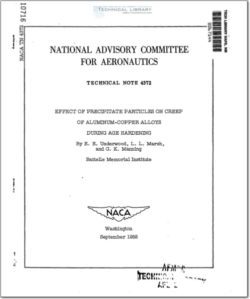NACA-TN-4372

- Version
- 79 Downloads
- 2.15 MB File Size
- 1 File Count
- March 24, 2016 Create Date
- March 24, 2016 Last Updated
National Advisory Committee for Aeronautics, Technical Notes - Effect of Precipitate Particles on Creep of Aluminum-Copper Alloys During Age Hardening

Spherical or platelike precipitates were prepared in aluminum alloys
with l to h weight percent copper. The effects of controlled sizes and
distributions of particles were determined by creep, tensile, and hard—
ness measurements, by quantitative metallographic evaluation of the par—
ticle characteristics, and by X—ray and electron—microscope examinations.
Single—phase strength curves, interpolated between high—temperature
and room—temperature data, give the strength of the alloy matrix which is
then subtracted from the neasured strength of the particulate alloy. The
difference is thus a measure of the contribution of the particles to the
strength of the alloy.
For spherical particles the usual decrease in strength with
increasing Spacing is noted up to a critical spacing of about 50 microns.
Beyond this critical spacing the strengthening due to_spherical particles
increases to a large value at spacings of about 500 microns. The same
shape of curve is obtained from roomptemperature tensile strengths as with
minimum creep rates, in spite of the profuse stress—induced precipitation
that occurs during the creep tests.
Platelike particles, on the other hand, show increased strengthening
as the spacings increase to about 15 microns, then a decrease in strength—
ening follows with wider spacings. At room temperature the particle
strengthening of platelets reaches about double the highest value attained
by spherical particles.
Reversals in the overall strengths of alloys with fine or coarse
spacings (less than the critical) are noted. At low and high stresses
alloys with finer spacings are stronger than those with coarse; at inter—
mediate stresses the alloys with coarse spacings are stronger.
The importance of the matrix composition in relation to alloy
strength is shown. Precipitation during the test does not necessarily
increase the strength of a two—phase alloy above that of a single—phase
alloy with the same overall composition.
| File | Action |
|---|---|
| naca-tn-4372 Effect of Precipitate Particles on Creep of Aluminum-Copper Alloys During Age Hardening.pdf | Download |

Comment On This Post